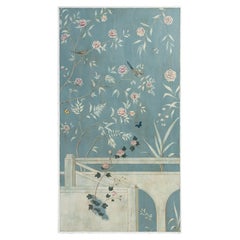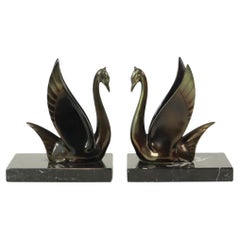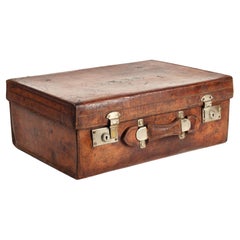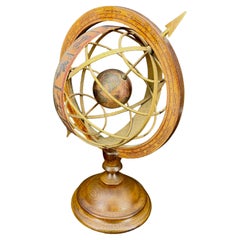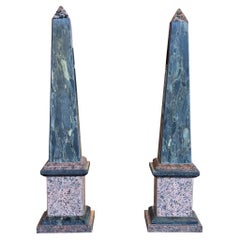European Home Accents
to
298
1,825
1,030
2,477
453
42
434
370
223
132
54
40
38
35
35
31
30
30
28
23
21
11
11
7
172
615
1,690
495
447
642
295
57
26
123
136
49
110
95
123
56
19
1,442
1,327
607
557
534
2,972
1,015
987
908
707
2,972
2,648
2,725
181
64
22
13
10
Place of Origin: European
18th Century Hand Painted Venetian Style Bellini Decorative Panel
By Porte Italia
Located in Ronchi dei Legionari, IT
From our hand painted Furniture Collection, we are pleased to introduce you to our Bellini Panel.
An exquisite decorative wooden panel inspired by the famous Venetian cocktail inven...
Category
2010s Other European Home Accents
Materials
Wood
French Art Deco Swan Bookends Marble Base 1930
Located in Poperinge, BE
Beautiful vintage French bookends, pair of art deco swan or grebe bookends with a black and white veined marble base, Nero Marquina marble, the swans are made of spelter metal that i...
Category
1930s Art Deco Vintage European Home Accents
Materials
Marble, Spelter
English Gentlemen Style Antique Leather Suitcase by Bick Bros Cheltenham 20th C
Located in London, GB
English Gentlemen Style Antique Leather Suitcase by Bick Bros Cheltenham
Step back into the golden age of travel with this handsome early 20th-century suitcase, made by Bick Bros of...
Category
1910s Edwardian Vintage European Home Accents
Materials
Metal
Mid-Century Modern Italian Globe for Bar Desk Table
Located in Haddonfield, NJ
Small Tabletop Vintage Wooden Spinning Globe, Marked "Made in Italy"
Charming hand-crafted Mid-Century Modern spinning tabletop globe featuring an antique design sepia brown world m...
Category
Mid-20th Century British Colonial European Home Accents
Materials
Metal
Gucci Horsebit Bookends, Tan Leather, Brass, Wood, Signed
By Gucci
Located in New York, NY
Gucci Horsebit Bookends, Tan Leather, Brass, Wood, Signed. Medium scale bookends finished in "Cognac Brown" leather and decorated with brass and wood equestrian horsebits. Signed wi...
Category
1970s Mid-Century Modern Vintage European Home Accents
Materials
Brass
Pair of 1920s Granite Obelisks
Located in Charlottesville, VA
Multi color stone obelisks. Very impressive.
Category
1920s Vintage European Home Accents
Materials
Granite
$2,400 / set
18th Century Hand-Painted Venetian Style Gold-Leaf Moro Screen with Chinoiserie
By Porte Italia
Located in Ronchi dei Legionari, IT
From our Hand-Painted Furniture Collection, we are pleased to introduce you to our Moro Screen.
Nature has always been a source of inspiration for our hand-decorated furnishings. We...
Category
2010s Other European Home Accents
Materials
Wood
MOD Raw Steel Room Divider or Wall Art with Interesting Repeated Pattern
Located in Los Angeles, CA
MOD raw steel room divider or wall art. Beautiful raw steel sheets with interesting repeat pattern and visible surface patina. Photographed with custom made wall mounts, can be order...
Category
Late 20th Century Industrial European Home Accents
Materials
Steel
19th Century French Patinated Wired Birdcage with Dome Top
Located in Dallas, TX
Bring the outdoors in with this large, elegant, antique birdcage. Crafted in France, circa 1880, this The birdcage features an elegant, domed design with intricate metalwork. The cur...
Category
Mid-19th Century Antique European Home Accents
Materials
Wire
Art Deco Bronze Bird Bookends Signed by C. Omin, Marcel Guillemard Foundry
By C. Omin, Marcel Guillemard
Located in Antwerp, BE
Art Deco bronze bird bookends signed by C. Omin, Marcel Guillemard foundry.
Stamped number.
Silvered bronze, France 1925.
Category
1920s Art Deco Vintage European Home Accents
Materials
Bronze
French Art Deco 3-Fold Gilt Screen with Upholstered Panels
By Sue et Mare
Located in Queens, NY
French Art Deco low 3 fold gilt screen with arch form center and upholstered panels in maroon with floral & bird design (attributed to SUE & MARE)
Category
1920s Art Deco Vintage European Home Accents
Materials
Giltwood, Upholstery
Antique Master Shipwright's Chest, English, Mahogany, Tool Trunk, Victorian
Located in Hele, Devon, GB
This is an antique master shipwright's chest. An English, ebonized mahogany tool trunk with ornate interior, dating to the Victorian period, circa 1880.
...
Category
Late 19th Century Victorian Antique European Home Accents
Materials
Mahogany
Unique Paravent- Lamp, Illuminated room divider from 1988 by Elsa Prochazka
By Woka Lamps
Located in Vienna, AT
Movable Room- divider with many tiny lamps outside.[nbsp]This piece of art is a unique piece[nbsp]designed by Elsa Prohazka and manufactured by WOKA LAMPS VIENNA[nbsp]for the Exhibition "WIEN MOEBEL" IN 1989, at the Vienna Secession Building. Several artists designed furniture and several manufacturer executed unique pieces of arts. The designers were Luigi Blau...
Category
Late 20th Century Modern European Home Accents
Materials
Steel
Vintage Handbag, Longchamp, Black Leather, XXth Century.
By Longchamp
Located in Saint-Ouen, FR
Vintage Handbag, Longchamp, Black Leather, XXth century.
Handbag by Longchamp, black leather, bamboo style gold buckle, leather cracked by time on the front, XXth century.
h: 29...
Category
20th Century Modern European Home Accents
Materials
Leather
Mid-Century Hand Carved Alabaster Owl Sculptures with Glass Eyes Bookends 1950s
Located in Lisse, NL
Beautiful, meaningful, practical and decorative mid-century bookends.
Given the fact that owls are the international symbol for wisdom and learning, these are the perfect sculptures...
Category
Mid-20th Century Mid-Century Modern European Home Accents
Materials
Alabaster
Library Ladder with Brass Top Handle
Located in Round Top, TX
Very nice library ladder with brass top handle. Rare and fun. Very cool.
Category
1940s Vintage European Home Accents
Materials
Brass
Louis Vuitton Trunk in Monogram, Louis Vuitton Steamer Trunk, Vuitton Courrier
By Louis Vuitton
Located in Saint-Ouen, FR
This spectacular Louis Vuitton steamer trunk features stenciled monogram canvas, deep black color lozine trim, LV stamped solid brass locks and studs as well as leather side handles ...
Category
Early 20th Century European Home Accents
Materials
Brass
Moynat Trunk, Moynat Steamer Trunk, Moynat Hat Trunk, Moynat Luggage
Located in Saint-Ouen, FR
This beautiful and very rare Moynat trunk features beautiful checkers canvas, chocolate color leather trim, large leather side handles with stamped Moynat...
Category
Early 20th Century European Home Accents
Materials
Brass
1920's Louis Vuitton Trunk, 70 cm Louis Vuitton Steamer Trunk, Vuitton Hat Trunk
By Louis Vuitton
Located in Saint-Ouen, FR
Superb Louis Vuitton steamer trunk featuring stenciled canvas, all leather trim in deep chocolate color, solid brass Louis Vuitton stamped clasps, lock and studs, solid brass corners...
Category
1920s Vintage European Home Accents
Materials
Brass
Room Divider with Aubusson Tapestries Featuring Birds and Floral Motifs
Located in Antwerp, BE
Four Panel Room Divider Screen with Aubusson Carpets - 20th Century
A beautiful four panel room divider decorated with fine Aubusson carpets depicting a lush Italian landscape. This...
Category
20th Century Aubusson European Home Accents
Materials
Copper
$6,493 Sale Price
30% Off
Louis Vuitton Trunk, Louis Vuitton Suitcase, Vuitton Steamer Trunk, Alzer 75
By Louis Vuitton
Located in Saint-Ouen, FR
This piece of luggage is a magnificent Louis Vuitton Alzer monogramm suitcase. This 75 cm suitcase is almost the largest and surely the most luxury one made by Louis Vuitton. It feat...
Category
21st Century and Contemporary European Home Accents
Materials
Brass
Mid-Century Antique Suitcase Covered in Blue Leather
Located in Lisboa, Lisboa
Antique travelling bag covered in blue leather. With gold-plated brass metal fittings on the edges, corners and zips. The structure is reinforced with studs all round, giving it robu...
Category
1950s Mid-Century Modern Vintage European Home Accents
Materials
Metal
Vintage French Wicker Basket, Gold Color Stitched Leather Bag Handles France
Located in Auribeau sur Siagne, FR
This bag is is wicker, rattan, with Stitched leather bag handles. the color is gold, with an old Patina.
This has been made in France circa 1970.
Category
1970s Vintage European Home Accents
Materials
Wicker, Rattan
$428 Sale Price
20% Off
set of Gucci displays
By Gucci
Located in Milano, IT
These stunning display stands by Gucci embody the elegance and sophistication of the iconic Italian brand. Each stand is adorned with the "Gucci" logo, engraved in polished brass let...
Category
1960s Modern Vintage European Home Accents
Materials
Brass
$1,783 / set
Empire Style Birdcage Model of Chateau de Luneville, Early 20th Century
Located in Spencertown, NY
The wood and wire birdcage faithfully depicting the chateau.
Category
Early 20th Century Empire European Home Accents
Materials
Wood
$16,000 Sale Price
20% Off
Antique Pair Of American Buffalo Bison Bronze and Marble Bookends 1920´s
Located in Buenos Aires, Olivos
Antique Pair Of American Buffalo Bison Metal Bookends.
Excellent details Bronze Sculptures, mounted over marble base.
Excellent condition.
We have specialized in the sale of Art Dec...
Category
Early 20th Century Art Deco European Home Accents
Materials
Marble, Bronze
$1,199 Sale Price / set
33% Off
Art Deco bronze cat bookends by Alexandre Kelety France 1930.
By Alexandre Kéléty
Located in Antwerp, BE
Art Deco bronze cat bookends by Alexandre Kelety.
Bronze with black patina. Portor marble bases.
France 1930.
Signed A. Kelety with stamped number....
Category
1930s Art Deco Vintage European Home Accents
Materials
Marble, Bronze
Leather Travel Trunk with Handles, France, 1940s
Located in Barcelona, ES
Beautiful leather trunk manufactured at the mid-20th century period in France.
It has very nice proportions, handles at both sides and 2 large solid metal rings at the back enable t...
Category
Mid-20th Century Mid-Century Modern European Home Accents
Materials
Metal, Iron
19th Century French Siege of Arras Floor Screen
Located in Nantucket, MA
Antique Louis XIV Siege of Arras floor screen, 19th century, a four panel screen with paper lithograph laid down on wooden panels, depicting the schematic pla...
Category
19th Century Louis XIV Antique European Home Accents
Materials
Paper
19th Century French Large Screen with Three Leaves in Hand Painted Canvas
Located in Sofia, BG
Lovely large French room divider or screen with three leaves in canvas hand painted in vivid colors with birds and foliage scrolls on blue base, after a pattern from a wall canvas pr...
Category
Mid-19th Century Antique European Home Accents
Materials
Canvas
$3,997 Sale Price
55% Off
Glass Voyeur Screen / Room Divider by Vittorio Livi for Fiam - 1990s
By Vittorio Livi, FIAM
Located in Linkebeek, BE
Glass Voyeur Screen / Room Divider by Vittorio Livi for Fiam - 1990s
Screen Vittorio Livi for Fiam
Measures: open 153cm-25cm H:167cm
Materials:glass - wood
Category
20th Century Mid-Century Modern European Home Accents
Materials
Glass, Wood
Double Sided Coromandel Chinoiserie Lacquer Five-Panel Screen, Paravent, 1890s
By Jean Dunand
Located in Biebergemund, Hessen
Exceptional double sided Chinoiserie hand-painted Coromandel screen, with a continuous scene over the panels. One side depicts a scene of the Forbidden City, and the other side shows...
Category
Mid-19th Century Chinoiserie Antique European Home Accents
Materials
Wood, Hardwood
Antique & Sturdy Solid Teak Wood Late Victorian Era Library Stairs / Steps 1890s
Located in Lisse, NL
Unique and top quality crafted, solid teak, library steps with dovetail joints.
In all our years of buying and selling rare antiques we have never had the priviledge of finding antique English...
Category
Late 19th Century Arts and Crafts Antique European Home Accents
Materials
Wood, Teak
Bamboo Wicker Rattan Screen Room Divider, Three-Panel Folder, 1960s
By Travail Francais
Located in Atlanta, GA
Crafted in France in the 1960s, this stunning rattan or wicker and bamboo three-panel room divider boasts a typical Mid-century filigree decoration. This rattan screen features mid-c...
Category
1960s Mid-Century Modern Vintage European Home Accents
Materials
Metal, Brass
1920s Goyard Hat Trunk, Goyard Trunk, Goyard Steamer Trunk
By Goyard
Located in Saint-Ouen, FR
This magnificent Goyard hat trunk features the very sought after chevrons pattern canvas, two large leather side handles, solid brass corners and Goyard engraved brass locks. It's al...
Category
1930s Vintage European Home Accents
Materials
Brass
Pair of 19th Century Ashford Black Marble and Pietra Dura Obelisks
Located in London, London
Pair of obelisks
Made from Ashford marble with pietra dura fronts
19th century
This striking pair of obelisks is crafted from Ashford black marble, a high-quality Derbyshire slate...
Category
19th Century Grand Tour Antique European Home Accents
Materials
Stone
Opto Folding Screen, Oak Frame and Black Corten Panels Minimalist Bauhaus Mood
By Lorenz+Kaz
Located in Milan, Lombardy
The structure of the folding screen is composed by four solid oak hand-made frames with an irregular geometry. Inside four contain black laser-cut steel panels.
Its name is Opto, because clearly inspired by the patterns of the optical Bauhaus artworks...
Category
2010s Minimalist European Home Accents
Materials
Lacquer, Oak
Pair Of Vintage Pointer Bookends, French Bronze, Dog Figure, Book Rest, Art Deco
Located in Hele, Devon, GB
This is a pair of vintage Pointer bookends. A French, bronze dog figure book rest, dating to the Art Deco period, circa 1930.
Fascinating Art Deco st...
Category
1930s Art Deco Vintage European Home Accents
Materials
Bronze
Art Deco style bookends PEGASE signed by Max Le Verrier, winged horses.
By Max Le Verrier
Located in Antwerp, BE
Art Deco style bookends PEGASE signed by Max Le Verrier.
With foundry mark. Patinated Art Metal on Black marble base.
Design 1930.
Posthumous contemporary cast.
Pegasus, winged hors...
Category
2010s Art Deco European Home Accents
Materials
Belgian Black Marble, Metal
Antique French Travel Trunk
Located in Newtown, CT
Antique French Travel Trunk. Well made late 1800's. It measures 20" deep and high and 35.75" wide. Wear is consistent with age. Nice graphics and the handles are stamped LV.
Category
Late 19th Century Victorian Antique European Home Accents
Materials
Canvas
19th Century Spanish Victorian Carved Walnut and Bronze Reliefs Sewing Table
Located in Miami, FL
19th Spanish Victorian carved walnut and bronze reliefs sewing table
Spectacular sewing table with carved edges, bronze legs and beautiful bronze sculptures reliefs decorating aroun...
Category
Mid-19th Century Victorian Antique European Home Accents
Materials
Bronze
Vintage Louis Vuitton Steamer Bag
By Louis Vuitton
Located in Los Angeles, CA
Classic vintage Louis Vuitton steamer bag. Large, oversized bag, perfect for weekend trips. LV monogram print with saddle leather and bra...
Category
1970s Vintage European Home Accents
Materials
Brass
$11,500 / item
Large 16th century carved and polychroom painted oak Venetian chest, Italy
Located in Meulebeke, BE
Italy / 16th century / Venetian chest or Cassone / oak, polychroom / antique / renaissance
A large carved and gilt painted Venetian marriage chest made in oak in the 16th century i...
Category
16th Century Renaissance Antique European Home Accents
Materials
Wood, Oak
Circa 1650 Sheet Iron Money Chest from Southern Germany with Wooden Stand
Located in Dallas, TX
In 15th and 16th century Europe, the works of blacksmiths from southern Germany were known far and wide. Demand for products by these skilled metal workers spread as far as the Scandinavian countries. Perhaps one of the most intriguing items that was produced by these workshops was the iron money...
Category
Mid-17th Century Baroque Antique European Home Accents
Materials
Iron
Antique 20th Century Louis Vuitton Trunk In Monogram Canvas, France c.1900
By Louis Vuitton
Located in Royal Tunbridge Wells, Kent
Gorgeous and most importantly complete, this early 20th century Louis Vuitton trunk was the must have item of any elite traveller. Covered in the world famous LV monogrammed canvas, ...
Category
20th Century Other European Home Accents
Materials
Brass
French Gilt Tole Hexagonal Pagoda Birdcage with Bells
Located in West Palm Beach, FL
French Gilt Tole Hexagonal Pagoda Birdcage with Bells
France, 1900s
This exquisite French gilt-tone hexagonal pagoda birdcage, dating from the early 1900s, is a beautifully made an...
Category
Early 20th Century Chinoiserie European Home Accents
Materials
Metal
$1,196 Sale Price
20% Off
Rattan Bamboo Folding Screen Room Divider, 1960s
Located in Barcelona, ES
Eye-catching handcrafted rattan / wicker and bamboo three-panel folding screen / room divider with filigree decoration. Manufactured in Spain, 1960s.
This rattan folding screen combi...
Category
20th Century Mid-Century Modern European Home Accents
Materials
Bamboo, Wicker, Rattan, Cane
$2,521 Sale Price
20% Off
Customizable Art Deco Style Mirrored Three Panels Brass Frame Screen
By Pescetta
Located in IT
Customizable Art Deco style mirrored three panels brass frame screen
Screen composed by three mirrored panels and brass frames. Ideal as room divider, to decor a fitting room...
Category
2010s Art Deco European Home Accents
Materials
Brass
English Regency Metamorphic Library Ladder
Located in Queens, NY
English Regency mahogany metamorphic library table/steps with hinged top & lion finial on a scrolled base. (with registry tag for J. Brodey, Bristo...
Category
19th Century Regency Antique European Home Accents
Materials
Bronze
20th Century Louis Vuitton Suitcase Alzer 80, 1970
By Louis Vuitton
Located in Epfach, DE
909481 Alzer 80 80 cm x 26 cm 52.5 cm with removable tray
Louis Vuitton suitcase, Alzer 80 with removable tray, in wonderful, well-kept condition with origin...
Category
20th Century European Home Accents
Materials
Leather
Bookends Chess Figures Carved in the Shape of The King, With Noble Wood Antique
Located in Mombuey, Zamora
Antique enigmatic Bookends,king Chess Pieces Carved in Wood
Bookends Chess figures carved in the shape of the King, With noble wood
Bookends carved in wo...
Category
19th Century Other Antique European Home Accents
Materials
Wood
Vintage Boho Goyard Steamer Trunk
Located in West Palm Beach, FL
Capture a piece of legendary French luxury with this authentic vintage steamer trunk from the esteemed Maison Goyard. An exquisite example of heritage craftsmanship, this trunk featu...
Category
Early 20th Century European Home Accents
Materials
Brass
Irish Peat Buckets
Located in Sturminster Marshall, Dorset
Georgian style brass bound mahogany turf, or Irish peat buckets. The tapered swirling moulded sides have polished brass bands and faceted and twist g...
Category
21st Century and Contemporary George III European Home Accents
Materials
Brass
$3,592 / set
Louis Vuitton Courrier Trunk in Damier Canvas 100 cm, Vuitton Steamer Trunk
By Louis Vuitton
Located in Saint-Ouen, FR
This Vuitton trunk is one of the rarer Louis Vuitton trunks to be offered currently. Indeed , it features the world famous and sought after damier (checkerboard) canvas. Dating to 1889, it is a wonderful example of such luxury trunks...
Category
Late 19th Century Antique European Home Accents
Materials
Brass
Original Early 1900s French Steamer Wardrobe Trunk Chest
Located in North York, ON
Original early 1900s French steamer trunk wardrobe chest. In all original good condition with original interior fitting, compartments, hangers and hardware. The interior and drawer c...
Category
1920s Industrial Vintage European Home Accents
Materials
Brass
$3,600 Sale Price
25% Off
Large French Pirate Corsair's Chest - Safe - Louis XIV Period - France XVIIth
Located in Beuzevillette, FR
Exceptional and extremely rare privateer/pirate chest in solid oak.
The wood is richly carved with rosettes.
The bottom of the trunk is pierced with holes...
Category
17th Century Louis XIV Antique European Home Accents
Materials
Wrought Iron
Columbus Earth Globe by Paul Oestergaard - Berlin ca. 1900
Located in Berghuelen, DE
Columbus Earth Globe by Paul Oestergaard - Berlin ca. 1900
An antique traditional Columbus earth globe with a wonderful patina. Edited by Paul Oestergaard and revised by C. Luther, ...
Category
Early 20th Century Victorian European Home Accents
Materials
Wood, Paper
Pair of Black Marble Obelisks
Located in Houston, TX
Lovely pair of Black Marble Obelisks.
Category
Mid-20th Century European Home Accents
Materials
Marble
$3,500 / set
Whimsical Knotty Pine Trunk / Storage Box
By Sarried Ltd.
Located in North Hollywood, CA
Whimsical solid pine trunk storage box with drapery motif and nailheads attributed to Sarried Ltd.
Category
1970s Bohemian Vintage European Home Accents
Materials
Pine
Exceptional 19th Century Italian Hand-Painted Leather Four-Fold Room Divider
Located in Alton, GB
A rare and remarkably preserved 19th century Italian four-fold leather screen, this antique room divider is a testament to the refined artistry and craftsmanship of the Romantic peri...
Category
Late 19th Century Romantic Antique European Home Accents
Materials
Leather, Wood
Recently Viewed
View AllMore Ways To Browse
Louis Vuitton Opera
Louis Vuitton Wardrobe Trunk
Antique Chinese Camphor Wood Trunk
British Leather Trunk
Louis Vuitton Brown Hat
Leather Dome Trunk
Victorian Steamer Trunk
Antique Padlock And Key
Courier Trunk
English Steamer
Hats Steamer
Italian Travel Trunk
Nailhead Trunk
Travel Trunk Italy
Trunk On Wheels
Upholstered Trunk
Antique Chinese Leather Trunks
Antique Embossed Trunk
